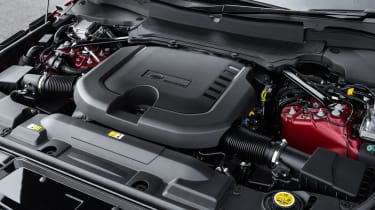Range Rover Sport review - engine and gearbox
New Ingenium units make up a majority of the engine range, the old supercharged V8 tops the range
Aside from the SVR, the top end of the Range Rover Sport’s engine range is a 519bhp supercharged V8 petrol unit familiar from performance variants of Jaguar saloons and coupes. Its relevance in a car this large and practically-minded is a debate for elsewhere; what’s hard to contest is that it lends the Sport an opulence no diesel engine (no matter how sophisticated) is capable of serving up.
Peak torque arrives at 2500rpm, but throttle response and accelerative thrust are impressive before this point in the rev range. It’s a hugely flexible engine, and despite having a claimed 2335kg to shift (2469kg on our scales), it never feels short on power. In fact, with third gear not reaching its rev limit until beyond 85mph, you’ll rarely use more than half-throttle in smooth, measured driving.
The ZF automatic gearbox is perfectly suited to the car, and there aren’t many scenarios that call for you to switch from its standard Drive to Sport mode, or to use its steering wheel-mounted paddles to swap ratios yourself. Should you decide to push the Sport harder, though, flicking between its eight gears is pretty intuitive.
Other engine options include a 296bhp or 345bhp 3-litre straight-six diesel, a 394bhp plug-in hybrid, which pairs a four-cylinder petrol with an electric motor and battery pack, a 394bhp straight-six petrol and a base-level 297bhp four-cylinder turbo petrol without the associated hybrid gubbins. Both six-cylinder engines are boosted by a subtle mild-hybrid system that does more for response than outright power.
When talking about an SUV pushing on for 2.5-tons, torque is the name of the game rather than top end power. The new Ingenium 6 diesel engine is ideal in this respect, building huge torque figures relative to its size.
There are two choices of four-wheel-drive systems, both of them permanent. A more off-road minded option offers up high and low range gearing, and in regular conditions, splits power 50/50 between the car’s axles, but can send 100 per cent of its power to either when required. Alternatively, a more road-biased option is simpler, with a single-speed transfer case, and a standard 42/58 front/rear torque split, with the potential for up to 62 or 78 per cent of power to go to front or rear axles respectively when required. This system is also 18kg lighter.




